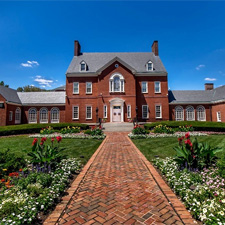
Government House
110 State Circus
Annapolis
MD 21401
410 974 3531
elaine.bachmann@maryland.gov
Government House is and has been the official residence of the governor of Maryland since 1870.
It is here that the governors and their wives or official hostesses have greeted and entertained important visitors to the state. Some of these illustrious guests have included Mark Twain; Her Royal Highness Queen Elizabeth, the Queen Mother; and Sugar Ray Leonard.
This is, however, much more than a residence. It has been, and continues to be, the center of the political and social life of this beautiful capital city. Government House is at the heart of Maryland history and the furnishing, paintings and other items within its walls tell the story of Maryland's rich and glorious past. Among its treasures are portraits by Charles Willson Peale, one of America's foremost portrait painters, and furnishings by Potthast, eminent Baltimore furniture makers of the 19th century. The house is also decorated with beautiful pieces from around the nation and the world.
As you see it today, Government House is a Georgian-style country house. When it was built in 1870, it was of the fashionable style of the period, a Victorian mansion with a mansard roof. Visitors to the house entered through magnificent walnut doors, carved with the Maryland coat of arms and symbols of Maryland industry and agriculture. The Victorian library now recalls the original ambience of Government House, and panels and rondels from those doors can be seen there.
This was not the first governor's residence in Annapolis. In 1733, the General Assembly authorized the purchase of land and construction of an official residence for the governor, but it was not until 1742 that Governor Thomas Bladen purchased a four-acre plot near College Creek and a dwelling was begun. Because of a dispute between Bladen and the House of Delegates, this house was never completed. After the Revolutionary War, the unfinished building was turned over to St. John's College and renamed McDowell Hall, after the college's first president.
The search for a suitable residence for the governor resulted in the acquisition of the Jennings House, which was leased by Governor Horatio Sharpe. In 1769, it was purchased by Governor Robert Eden, Maryland's last provincial governor. After his departure, the house was confiscated by the state and was used as the governor's residence for the next 90 years. In 1866, the Jennings House was sold to the U.S. Naval Academy and, in 1868, land was purchased on State Circle for a new Governor's residence. It was ready in 1870 for its first occupants, Governor Oden Bowie and his family.
In 1935-36, the conversion of Government House to its present appearance took place and, in 1947, more renovations, including cleaning, painting, and roof repairs were done. In 1987, a new skylight by Maryland craftsmen was installed and, in 1990, a fountain featuring Maryland symbols was placed in the garden.
There are seven public rooms in Government House: the Entrance Hall, the Victorian Parlor, the Federal Reception Room, the Empire Parlor, the Conservatory, the Drawing Room, and the State Dining Room. On display in Government House are many works from the state-owned art collections, installed by the Maryland Commission on Artistic Property of the Maryland State Archives. In the Entrance Hall are portraits of Queen Henrietta Maria, after whom Maryland was named, and Charles Calvert, Fifth Lord Baltimore. The portrait of Queen Henrietta Maria was painted in 1901 by Florence MacKubin after the original by Anthony Van Dyck, which hangs in Warwick Castle in England. A portrait of Frederick Douglass, commissioned in 2014 and painted by Simmie Knox, is on display in the Drawing Room, along with Charles Willson’s Peale’s portrait of George Washington painted during the Revolutionary War. The State Dining Room features the portrait of the Sharpe Family painted in 1753 and attributed to Arthur Devis. A portrait bust of Harriet Tubman, displayed on a wooden pedestal made from wood of Maryland’s historic Wye Oak, is displayed in the Conservatory.
Government House is administered by the Government House Trust which was established in 1980. In 1995, the General Assembly passed legislation to expand and strengthen the role of the Trust in the care, preservation, and interpretation of the public rooms in the residence which has played such an important role in the history of Maryland.


Entrance Hall

The Federal Parlour


